
 |
Tea Clipper |
 |
| from TeaAntiques.com | ||
| Edition Ninety Four |
My antique for this month is a charming 'Pearlware' tea canister made in Staffordshire, c1795.
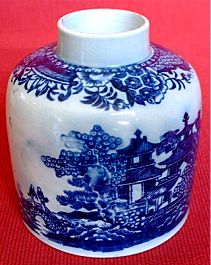
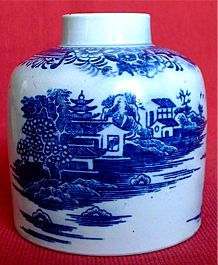
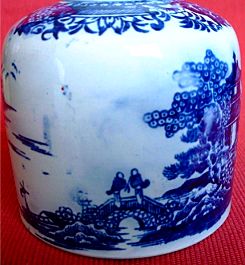
This delightful tea canister is of a cylindrical shape, with rounded shoulders and having a cylindrical neck. It is beautifully decorated with blue prints of oriental scenes. These scenes include temples, trees, islands as well as the two men crossing the oriental bridge in the foreground. These scenes are beautifully executed and of a rich deep blue. A beautiful early tea canister to grace any collection of English tea wares.
More details of this item and other tea related antiques can be found by visiting my web site at www.TeaAntiques.com.
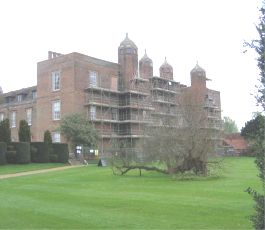 Melford
Hall is a house dating back to the 16th century and is set very close to the town
of Long Melford. It is built of locally made red bricks and from first appearance
has the typical Tudor outline of a house with tall turrets and towers. However,
the house over its long history has been victim of some savage blows, including
a major fire in 1942 which almost totally destroyed the north wing. It has also
moved with history and has now Georgian sash rather than stone mullion windows.
Melford
Hall is a house dating back to the 16th century and is set very close to the town
of Long Melford. It is built of locally made red bricks and from first appearance
has the typical Tudor outline of a house with tall turrets and towers. However,
the house over its long history has been victim of some savage blows, including
a major fire in 1942 which almost totally destroyed the north wing. It has also
moved with history and has now Georgian sash rather than stone mullion windows.
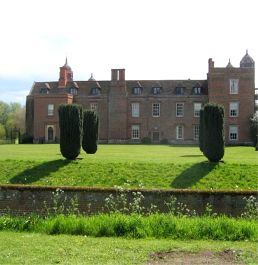 Being
situated literally at one end of the town, in order to give a more imposing approach
to the house a drive was created taking you right round a dry moat to the rear of
the house, which is now the East Front. This elevation of the house is dominated
by two tall hexagonal turrets either side of the open courtyard. These turrets contain
staircases that would have provided access to the first floor, roof and also to
the East Range, now demolished, that would have created an enclosed courtyard. The
stone mullion windows at the ends of the wings may look like the originals, but
these were installed in the 19th century.
Being
situated literally at one end of the town, in order to give a more imposing approach
to the house a drive was created taking you right round a dry moat to the rear of
the house, which is now the East Front. This elevation of the house is dominated
by two tall hexagonal turrets either side of the open courtyard. These turrets contain
staircases that would have provided access to the first floor, roof and also to
the East Range, now demolished, that would have created an enclosed courtyard. The
stone mullion windows at the ends of the wings may look like the originals, but
these were installed in the 19th century.
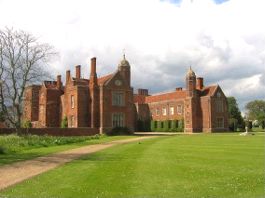
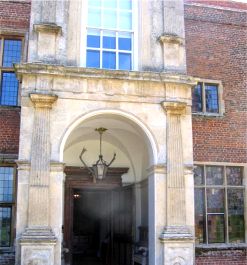
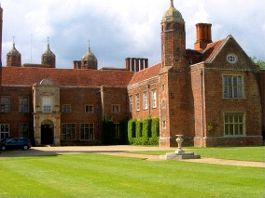
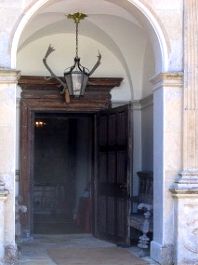 In
the centre of the house is a stone two story porch through which you enter The Hall.
This Hall was the Great Hall of the medieval house and it is here where the whole
of the household would have taken their meals. This space was transformed in 1813
by Thomas Hooper by adding a huge stone fireplace, doorcases and other classical
features. To the left is a grand staircase added at this period by Hooper. The Hall
contains some interesting early English Oak furniture and contemporary portraits.
There are a two fine marquetry chests, known as 'Nonsuch chests', as similar early
chests were said to have palaces on them depicting King Henry VIII long-lost Nonsuch
Palace in Surrey.
In
the centre of the house is a stone two story porch through which you enter The Hall.
This Hall was the Great Hall of the medieval house and it is here where the whole
of the household would have taken their meals. This space was transformed in 1813
by Thomas Hooper by adding a huge stone fireplace, doorcases and other classical
features. To the left is a grand staircase added at this period by Hooper. The Hall
contains some interesting early English Oak furniture and contemporary portraits.
There are a two fine marquetry chests, known as 'Nonsuch chests', as similar early
chests were said to have palaces on them depicting King Henry VIII long-lost Nonsuch
Palace in Surrey.
At the end of the Hall opposite the Grand Staircase is the Dining Room. This is in the wing of the house that was destroyed by fire in 1942 and so is relatively new. It is a very light and elegant room with white walls and polished stone floor. This is a perfect foil for the beautiful Georgian furniture. A set of tassel-backed mahogany dining chairs with claw feet c1730 are set around an oval mahogany dining table. A further set of dining chairs are positioned around the room and are of walnut, c1740-60, possibly Irish in origin and having neatly carved back splats.
On the dining table are a set of Coalport dessert plates and comports, each piece beautifully decorated by hand with botanical flowers, including the most attractive striped tulips and roses. For the tea ware collector, there is a handsome silver 'melon' shaped tea urn on one of the side tables.
To the left of the Dining Room is the Blue Drawing Room. This is very un-Tudor like in appearance having blue and white painted panels and ornate carved and painted fireplace. The fire did not reach this part and so what we see today is the early eighteenth century rococo decoration and very elegant it is too. Either side of the fireplace are two pretty pole screens with beautifully embroidered screens, used to protect ladies' faces from the heat of the fire. Other exquisite items of Georgian furniture can be seen in this room as well as a very rare long case clock with seaweed marquetry, c1700 that only requires winding once a year!
Moving on into the Library takes us into another period, this time early nineteenth century Regency. This very handsome room could not be more Regency in style if it tried. It has built in curved book cases at the end through which you enter and the door through which you pass on the Library side is carefully designed to look like part of the book case when closed. The room was created in 1813 and has scagliola Ionic columns creating a clever division within the room. There are Regency details in the pretty frieze, including the Greek key and anthemion. There is a striking pair of day beds, or 'Grecian couches' attributed to Gillow's of Lancaster. These are spectacular with heavily carved eagles and eagles feet for supports and the pair upholstered in typical Regency stripe fabric.
In a glass cabinet in The Hall by the foot of the Grand staircase, can be seen some of the family porcelain, which includes many pieces from eighteenth century Chinese 'armorial' tea wares.
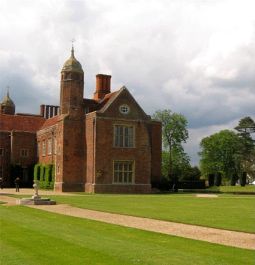 Making
your way up the Grand Staircase it leads to a room, called The Boudoir, created
on the landing. There are glass fronted cabinets to one side which contain porcelain
including a Meissen floral dessert service and some 18th century English drinking
glasses. Also on the landing is a stunning stained glass window depicting
a portrait of Queen Elizabeth I. She is seen wearing a beautiful jewel encrusted
blue dress that she wore to St Paul's Cathedral in November 1588 to give thanks
for the defeat of the Spanish Armada.
Making
your way up the Grand Staircase it leads to a room, called The Boudoir, created
on the landing. There are glass fronted cabinets to one side which contain porcelain
including a Meissen floral dessert service and some 18th century English drinking
glasses. Also on the landing is a stunning stained glass window depicting
a portrait of Queen Elizabeth I. She is seen wearing a beautiful jewel encrusted
blue dress that she wore to St Paul's Cathedral in November 1588 to give thanks
for the defeat of the Spanish Armada.
On the first floor is a room dedicated to Beatrix Potter, authoress of the famous children's books. She is linked with this house as she was a cousin of Ethel, Lady Hyde Parker, the grandmother of the present Baronet. She visited Melford Hall on many occasions and sketched some of her story book characters in the house and garden. There is a model of one such character 'Jemima Puddle-Duck' that was a present from Beatrix Potter to the Hyde Parker children.
Near to the Beatrix Potter exhibition room is the Victorian Bedroom, the bedroom used by Beatrix Potter when she visited the house.
Taking stairs back down to the ground floor, the National Trust , who have only recently taken custodianship of the North wing, have opened a very small room in which they sell tea and limited cakes. Tea is served in paper cups and cakes on paper plates, but is better than nothing, which it was prior to this opening in 2008.
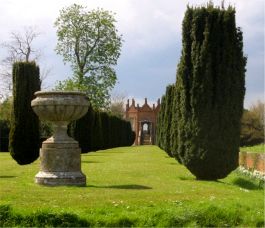
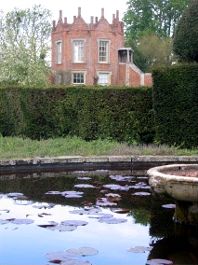 Much
of the original formal gardens of the house have been swept away, but a small formal
garden still remains with a circular lily pond. One of the most charming feature
in the garden is the Banqueting House, situated in the north-west corner of the
garden. This strikingly beautiful red brick octagonal building has triangular pediments
and elegant white wooden sash windows. It is the principle survivor of the early
garden design at Melford Hall, possibly dating from the early 17th century. It is
entered up a short flight of steps with a stone columned porch at the top. According
to the inventory of 1635, it was quite grandly furnished, with a marble table and
five gilt wood chairs. The wood panelling on the walls and sash windows were installed
in the 18th century. At the same time a fascinating system of heating pipes were
installed linked to a furnace below so that the pavilion could be heated to allow
its use as an Orangery.
Much
of the original formal gardens of the house have been swept away, but a small formal
garden still remains with a circular lily pond. One of the most charming feature
in the garden is the Banqueting House, situated in the north-west corner of the
garden. This strikingly beautiful red brick octagonal building has triangular pediments
and elegant white wooden sash windows. It is the principle survivor of the early
garden design at Melford Hall, possibly dating from the early 17th century. It is
entered up a short flight of steps with a stone columned porch at the top. According
to the inventory of 1635, it was quite grandly furnished, with a marble table and
five gilt wood chairs. The wood panelling on the walls and sash windows were installed
in the 18th century. At the same time a fascinating system of heating pipes were
installed linked to a furnace below so that the pavilion could be heated to allow
its use as an Orangery.
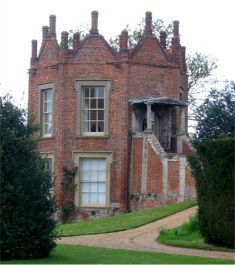
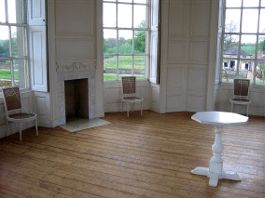
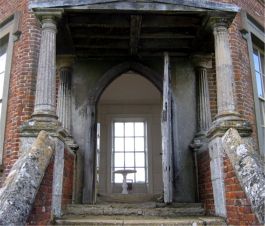
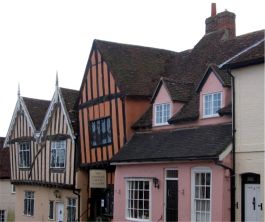
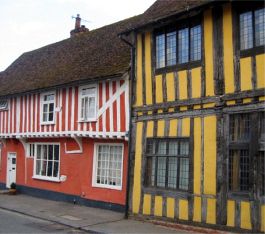 Whist
visiting Melford Hall you may like to visit the town of Long Melford or travel a
little further to the attractive and quintessentially English town of Lavenham,
Suffolk.
Whist
visiting Melford Hall you may like to visit the town of Long Melford or travel a
little further to the attractive and quintessentially English town of Lavenham,
Suffolk.
In Lavenham the 15th century houses are half timbered and painted in pretty colours. Many of the houses are now set at odd angles, leaning this way and that, as if weary of standing upright for so long! In the centre of the town is the Guild Hall, run by the National Trust and open to the public and contains a museum of local history. It also contains a tea shop, so if you have not taken afternoon tea at Melford Hall, maybe this is an ideal place.
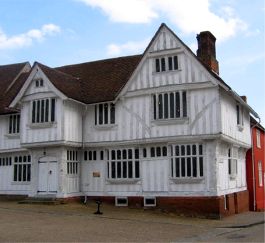
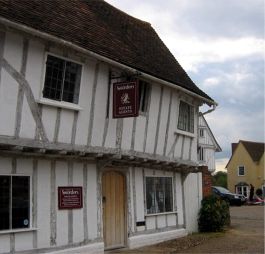
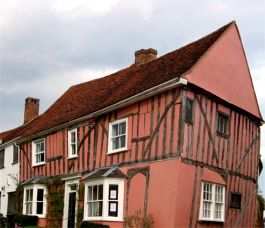
To review past newsletters, just follow this link:
Past newsletters.
To subscribe to this free newsletter -
Click here